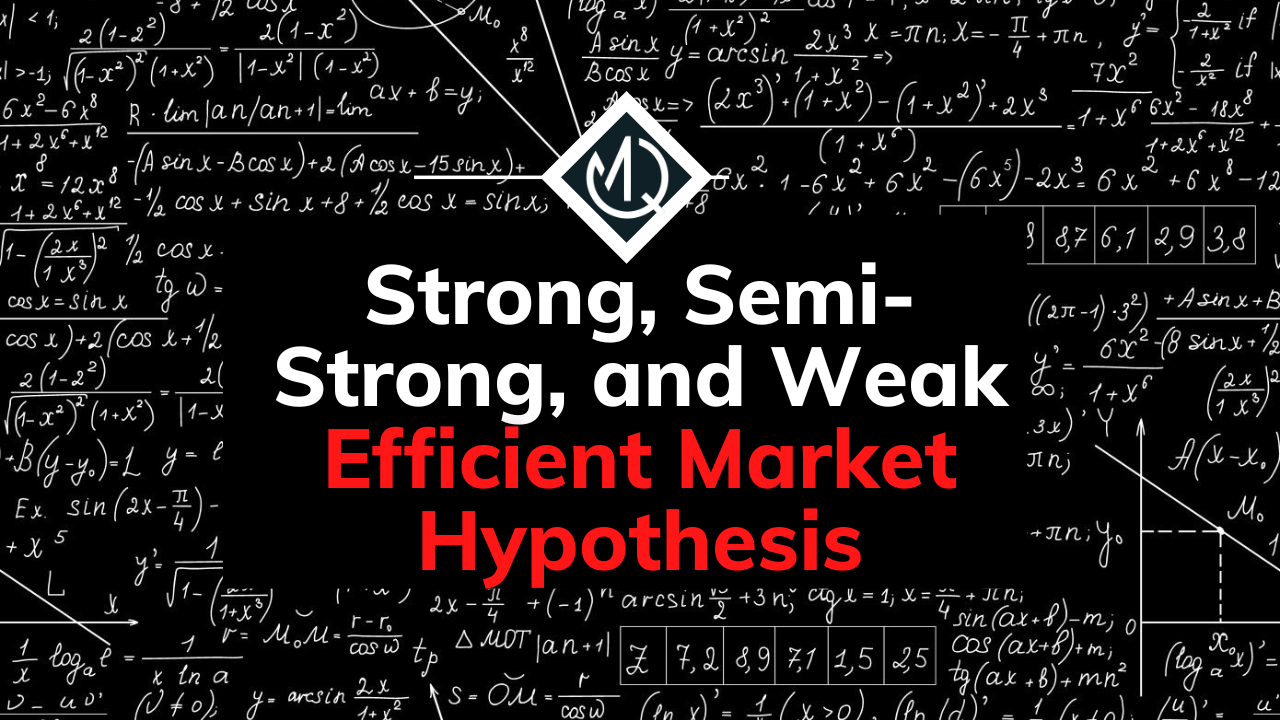When it comes to evaluating companies and creating investment strategies, the efficient market hypothesis serves as one of the most important concepts that any sophisticated professional should understand. This theory postulates that markets are efficient and thus do not offer any possibilities of obtaining above-average returns (on a risk-adjusted basis).
Having said that, there are three different definitions of efficiency, each one less strict than the previous one. In this article, we will go through each one of them and discuss them in detail.
The efficient market hypothesis allows for three different definitions of efficiency:
- Strong Efficiency
- Semi-Stong Efficiency
- Weak Efficiency
Without any further ado, let’s describe each one of them!
Table of Contents
Which are the three forms of the Efficient Market Hypothesis?
The Efficient Market Hypothesis (EMH) is a theory that was written in the year 1970 by Eugene Fama. It postulates a market is efficient when the price of financial assets is correctly based on all existing information. Thus, it is not possible to use this data in order to obtain above-average returns.
Another consequence of this postulate is the theoretical impossibility of arbitraging the price of an asset and obtaining an extraordinary profit based on an analysis of it.
This is because the asset price would change so quickly (whatever the factor affecting its price) that it would be impossible to buy or sell any of them at undervalued or overvalued prices.
In simple terms, the theory of the efficient market hypothesis maintains that at all times and places, the price of an asset is at equilibrium and that agents duly incorporate all available information when valuing it.
Having said that, the degree of efficiency of a given market is also determined by the number of participants (the more they are, the higher the market efficiency will be) and the transaction and information costs (the higher they are, the lower the market efficiency will be).
This theory contemplates three types of efficiency: strong efficiency, semi-strong efficiency, and weak efficiency. Each of these variants is distinguished by having stronger or looser assumptions regarding the definition of efficiency.
Next, we will go on to describe each type of efficiency in more detail.
Strong Efficiency
A strong efficiency market is one where asset prices are reflected by any type of existing information, whether it is public, private, or historical information. In this type of market, no matter what happens, the price will always be adjusted in such a way that no extraordinary profit can be made.
The strong efficiency assumption does not even contemplate the possibility of obtaining an income from the private information that investors possess, nor does it contemplate the existence of privileged information.
The strong efficiency version of the efficient market hypothesis does not contemplate the existence of asymmetrical information of any shape or form. Thus, since investors do not have useful or exclusive information that would allow them to trade at an advantage, they are unable to obtain consistent above-average returns.
Semi-Strong Efficiency
If the market has semi-strong form efficiency, it is assumed that asset prices already contain all public and historical data. In this scenario, it is not useful to use fundamental analysis to infer whether the asset is undervalued or overvalued since this analysis uses public information which is already reflected in the price of the assets.
In other words, in the face of any news or event, the value of the assets would be adjusted in such a way that the investor could not use this type of information in his favor. The only way for the investor to obtain benefits would be through private or privileged information, which in turn has an acquisition cost for the investor (the costs of said information should not exceed the benefits generated by the investments). Likewise, the use of privileged information is illegal and duly controlled in most developed financial markets.
Weak efficiency
Weak efficiency holds that the historical prices of an asset are properly incorporated into its current price. In a market with weak efficiency, past and future prices have no relation to each other. In other words, prices are not autocorrelated.
Therefore, the only way for the investor to obtain any extraordinary profit is through the use of public and private information since this would allow him, at least in theory, to infer the future price based on fundamental analysis, news sources, or other alternative information.
The weak efficiency hypothesis is the most widely accepted in the empirical literature.
Relationship between Efficient Market Hypothesis and Random Walk Theory
In mathematical terms, a Random Walk is a process that consists of a sequence of random steps. In other words, tomorrow’s price will equal today’s price plus a random and unpredictable component.
Likewise, the price in 2 days will be tomorrow’s price plus another random component, or the price of today plus 2 random components. In finance, this random component usually has a mean of 0 and follows a normal distribution.
As a consequence of this, our best forecast for tomorrow’s price will be to say that it will be the same as today’s price. This is because the random component can be both negative and positive, and so we cannot even determine the direction of the following change in price. But we know (or at least assume) that the randomness has a mean of 0, which leads us to predict that the next price will be equal to the current price.
The supposed randomness of the series lies in the different forms of efficiency that we mentioned previously. Even assuming weak efficiency, the validity of the random walk model stands.
As previously said, the EMH also tells us that prices move randomly. New information, such as news, is, by definition, also not predictable, so the moment it becomes known and the effect it will have will also be random.
As we can see, both models are compatible in that they both state that it is impossible to predict future asset prices.
It is because of this that the theory of efficient markets is frequently modeled mathematically through a stochastic process of this type. The Ornstein-Uhlenbeck process is the most used in financial mathematics in these cases.
Frequently Asked Questions
Is technical analysis compatible with the Efficient Market Hypothesis?
Technical analysis is a technique used to study the price of assets based solely on past price and volume data. Adherents to this trading methodology maintain that price series contain patterns that repeat themselves over time and can therefore be used to forecast future variations.
Now, following the concepts of the EHM, is technical analysis useful to us? The answer, in principle, is quite simple: no.
Why is there no value in using technical analysis according to Eugene Fama’s theory? Even in a market with weak form efficiency, future and past prices do not correlate with each other. Therefore, we can conclude that technical analysis and EHM are mutually exclusive.
Are Mean-Reverting and Momentum Strategies compatible with the Efficient Market Hypothesis?
Mean reversion is a trading strategy that is based on mathematical and statistical tools. It tells us that the price of an asset that is trending in one direction will return to its average value in the long term. In other words, this type of strategy maintains that a change in the price of an asset may be due to transactional reasons and temporary inefficiencies, after which the price is expected to converge to its average.
It is common practice to use technical indicators such as the Moving Average Crossover Divergence (MACD) or the Relative Strength Index (RSI) to design mean reversion strategies. The most sophisticated investors, in quantitative terms, use econometric techniques to determine if an asset has (or does not) tend to mean revert. The statistical test used par excellence for these cases is the Hurst Exponent.
Now, are mean reversion strategies compatible with the efficient market hypothesis?
Mean reversion strategies are not compatible, at least in theoretical terms, with the efficient market hypothesis. These strategies are in contradiction with even the laxest version of efficiency: the weak market efficiency. This is because, at least in theory, no information can be extracted based on past prices. The same happens with momentum strategies, which expect price increases (decreases) to be followed by subsequent price increases (decreases).
Is the Efficient Market Hypothesis compatible with Behavioral Finance?
Behavioral Finance is a discipline that studies the way in which human beings make decisions and how these decisions are not always rational or efficient. These mistakes, which are called “cognitive biases,” have been extensively studied empirically and contradict the old paradigm of the rational agent (homo-economicus).
The various and interesting biases studied are several and are beyond the scope of this article, but the reader can refer to the following article.
A clear example of the irrationality of agents when making their investment decisions was presented by Richard Thaler (2016 Nobel Prize). In it, he names the case of the investment company Herzfeld Caribbean Basin Fund, better known as CUBA. Despite the name, this fund does not have hold any assets from the country of the same name. Despite this, the fund has always traded at a discount of 10%-15% compared to a portfolio replicating the same holdings (same net asset value or NAV). The difference, Thaler argues, is only explainable by the name of the fund, thus being a clear example of irrationality.
In the graph, we can see CUBA’s share price and its net asset value from May 2014 to March 2015. While in the early months, the share price tended to be discounted by 10% to 15% with respect to the NAV (as said before), it can be seen that said trend reversed as of December 18, 2014.
But why did this abrupt change occur? The sudden rise in the value coincided with the announcement by Barack Obama (President of the USA at the time) of trying to “relax” diplomatic relations with Cuba. This led markets being optimistic regarding the Cuban economy, and due to irrationality, this optimism also affected the CUBA fund. This event and its consequences on the price of the fund are additional arguments that show a clear example of a strong inefficiency in the market.
What is the relationship between High-Frequency Trading and the Efficient Market Hypothesis?
High-frequency Trading commonly refers to trading algorithms that specialize in exploiting some kind of inefficiency with the least possible latency. Thus, companies specializing in this type of trading develop tailor-made hardware and place and colocate it in the same building as the exchange’s servers. They do the latter to minimize the cable distance between their algorithm’s processor and the Exchange’s processor, which reduces the time required for sending an order and processing it.
These algorithms are used to exploit small inefficiencies, which, if exploited frequently, can lead to considerable profits. If you want to learn more about HFT, you can read this article I wrote.
According to the hypothesis, the inefficiencies of the markets disappear immediately thanks to the efficient agents that arbitrate them. At first glance, the existence of high-frequency trading does not seem to contradict the EMH.
However, we must bear in mind that the EMH maintains that these arbitrations are carried out by various agents and cannot be exploited in a consistent manner by the same agent. But, due to the nature of high-frequency trading, these algorithms are of a winner-takes-all type. Taking into account that each type of possible arbitrage is commonly exploited by its respective fastest algorithm, extraordinary rents can be extracted consistently. This implies a contradiction with the efficient market hypothesis.
Can the Efficient Market Hypothesis explain Market Bubbles?
According to the efficient market hypothesis, financial bubbles should not be able to form. This is because bubbles, by definition, imply that asset prices are strongly above the equilibrium price. Likewise, during the formation of a bubble, extraordinary profits are also obtained through momentum strategies. Momentum is the expectation that a rise (fall) in a price will be followed by another rise (fall) in that price.
As with mean reversion, momentum should also not exist under either version of market efficiency. However, both phenomena have been extensively studied and tested in the academic literature.
Who defined the Efficient Market Hypothesis?
The Efficient Market Hypothesis was formulated for the first time by Eugene F. Fama in 1970. It is based on three characteristics that investors usually possess: rationality, independent deviations of rationality, and arbitration.
- Rationality means that investors will price assets consistently. That is, according to the expected cash flows discounted at the corresponding discount rate and the available information of that asset.
- Independent deviations from rationality contemplate the possibility that some individuals erroneously value an asset.
- Arbitrage neutralizes individual deviations since rational agents will buy cheap assets and sell expensive assets, thus converging the respective prices to their equilibrium values.



No responses yet